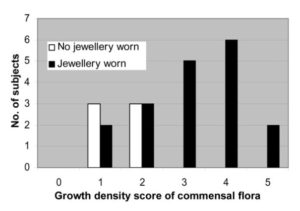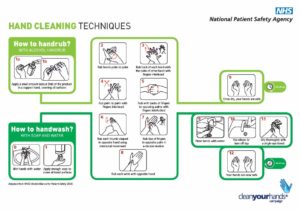In our recent post, we summarized how rings may affect hand hygiene and why ring wearing during patient care is a complicated issue. Healthcare-workers (HCW) wear watches and bracelets almost as often as rings, so next, we collected some evidence regarding watches and hand hygiene.
Just as in the case of rings, let us clarify in the beginning that all jewelry must be taken off before surgical hand preparation [1, 2]. In this post, we only address routine patient care.
In contrast to wearing rings, CDC and WHO do not have recommendation against watches. The WHO guideline (published in 2009) says that “investigate the impact of wearing a watch on the efficacy of hand hygiene” is an open question, that requires more research and field tests [2].
Hautemaniere et al. 2010 reported that wearing watches and bracelets were both risk factors for poor hand hygiene (odd ratio, OR 2.03 and 1.95, respectively). This study was based on direct observation of 3067 HCW in France, using the fluorescent trial [3]. Ramón-Cantón et al. 2011 used similar study design, and observed 293 HCW in a Spanish hospital. They found “missed” areas on the wrist in 90% of those, who wore watch and 56% of those, who did not. The situation was quite the same for bracelets; there were missed areas on the wrist in 93% of those, who wore bracelet, while 61% of those who did not. They reported that 36% of HCW wore watches and 13% wore one or more bracelets [4]. Both studies agreed that wearing watches has a negative impact on hand hygiene.
Alp et al. 2006 studied the hands of laboratory workers in a Dutch hospital. Laboratory personnel are exposed daily to germs, many cases of laboratory-associated infections were reported. Microbiological samples were taken from hands and wrists. Total bacterial load was elevated in the case of HCW who were wearing jewelry (Figure 1). Pathogenic microorganisms were found on hands of 379 persons who wore jewelry (ring, bracelet or watch), and no one, who wore no jewelry [5]. Field et al. 1996 also reported that significantly greater number of bacteria can be isolated under watches compared to the control sites [6].

Fagernes and Lingaas 2011 also studied the impact of watches on the hand’s microbiology. 465 Norwegian HCW in an intensive care unit were sampled by the glove juice method. They found that wearing watches was associated with enhanced total bacterial count; they found more than three times (OR 3.25) as many bacteria on hands with watches compared to control hands. Based on this data, they concluded that HCW should not wear watches during patient care. They also mentioned an interesting correlation; 64% of ring wearers used watch, compared to 15% in case of HCW without ring [7].
One other aspect of watch wearing should also be mentioned. While the WHO promote the 6-step hand hygiene method, in several countries/hospitals a 7-step hand hygiene protocol is used, where the additional, last step is rubbing the wrist. (The efficacy of that 7th step will be the topic of a future post). Obviously, wrist cannot be rubbed, if HCW wears watch or bracelet.

NHS (National Health Service in England) also use the 7-step protocol. Not surprisingly, their national guideline says that “wrists need to be fully exposed to the hand hygiene product and therefore should be free from jewelry and long-sleeved clothing” [8].
CONCLUSION:
The WHO hand hygiene guideline does not give any recommendations about wearing watches (or bracelets) during regular patient care, as the time it was written there was a lack of scientific evidence of their impact. We presented three studies, all published after the WHO guidelines. These used different methods, but all agreed that wearing watches has negative effect on hand hygiene. National guidelines (like NHS guideline in the UK) may already contraindicate wearing watch or any wrist jewelry.